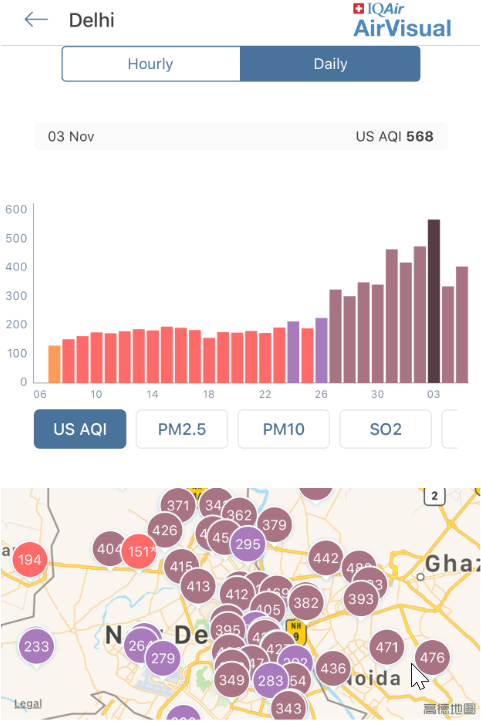Delhi residents entered a 10-daystreak of hazardous air pollution in November 2019.
India’s capital city passed the unhealthy milestone a day after authorities introduced a temporary rule to reduce cars on the roads to try to lower pollution levels.
Overall, daily Delhi air quality was hazardous from Sunday, October 27 to Tuesday, November 5.
During that time, the air was coated with a thick brownish haze. City schools have closed. Flights have been canceled or diverted because of poor visibility. Authorities have enacted a measure to take 4 million cars off the roads by only allowing cars with odd or even license plates on alternate days.
On the worst day – Sunday, Nov. 3 – the average concentration of PM2.5 (fine particulate matter) across the whole city was 509.2 micrograms per cubic meter (µg/m3),a 568 on the U.S. Air Quality Index and more than 50 times the World Health Organization’s recommended annual guideline.
Delhi hazardous air pollution

Delhi residents breathe through at least nine days of consecutive hazardous air pollution, as shown on the AirVisual air quality app
Delhi’s air quality was consistently unhealthy since Diwali in late October when a ban on conventional firecrackers failed to stop pollution levels soaring during India’s biggest annual festival.
Why is Delhi's air quality so bad?
The sources of Delhi’s pollution generally include vehicle emissions, industry, construction, power plants, and waste-burning.
Current smog levels have been made worse by weather conditions and the actions of farmers in the neighboring states of Punjab and Haryana, whoburn fields to clear the land after crops have been harvested – known as stubble burning – producing smoke that travels across large distances. There is rarely animmediate let-up in this smoke, as the harvest season lasts until mid-November. Major fires can be seen on the AirVisual air quality and fires map.
Meanwhile, falling temperatures and a lack of rain and winds in Delhi have meant pollutants have stayed around for longer.
Delhi’s previous record was eight consecutive days of hazardous air quality between Nov. 7-14, 2017. The publishing of real-time air quality data in Delhi started in January 2016.
The city average is worked out using the median of all stations reporting timely PM2.5 data across Delhi. During Delhi’s bout of hazardous air pollution, areas of the cityexperienced pollution levels more than 150 times the WHO guideline– for example, in Vivek Vihar the U.S. Air Quality Index reached 1604– with a PM2.5 concentration of 1542 µg/m3 – on Sunday, Nov. 3.
The number one air cleaning solution for your home.
Lorem ipsum Donec ipsum consectetur metus a conubia velit lacinia viverra consectetur vehicula Donec tincidunt lorem.
TALK TO AN EXPERTArticle Resources
Article Resources





